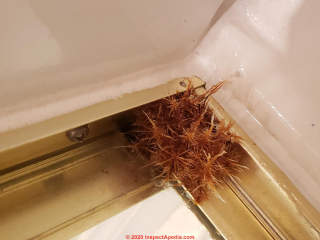 How Dangerous is Brown Hairy Mold Found in Bathrooms?
How Dangerous is Brown Hairy Mold Found in Bathrooms?
Toxicity of Stemonitis sp. S. fusca, & other species
- POST a QUESTION or COMMENT about the identification, cause, & cure of brown hairy mold and other brown bathroom molds.
Brown hairy mold in bathrooms (and on OSB subfloors):
This document gives advice on identification of and health risks of brown hairy mold found in bathrooms (and other building areas), including brown hairy Stemonitis sp. mold found on bath floor tiles, under carpeting, on wood subflooring.
InspectAPedia tolerates no conflicts of interest. We have no relationship with advertisers, products, or services discussed at this website.
- Daniel Friedman, Publisher/Editor/Author - See WHO ARE WE?
Identifying & Removing Dense Brown Hairy Mold
 Here we also discuss how to address the risk of further hidden bathroom mold, and we cite references on the toxicity of Stemonitis sp. - a brown hairy myxomycete mold found on OSB, wood subfloors, and in some bathrooms such as the bath floor shown in our page top photograph.
Here we also discuss how to address the risk of further hidden bathroom mold, and we cite references on the toxicity of Stemonitis sp. - a brown hairy myxomycete mold found on OSB, wood subfloors, and in some bathrooms such as the bath floor shown in our page top photograph.
This article series helps identify the presence of or locate the probable sources of mold reservoirs in buildings, and helps decide which of these need more invasive, exhaustive inspection and testing.
Question: what is this hairy brown mold found in my bathroom? Is brown hairy mold dangerous? How do I get rid of it?
I live in Melbourne Australia and I have a major issue with my bathroom floor. Please see my brown hairy mold photographs (below). The images are of brown mold growths on the bathroom floor, & afterwards when I had scraped them off the floor.
I do understand that no competent expert would pretend to ID mold [or any other microscopic particle] from just a field photo.
But I have no idea what I'm dealing with and of course am concerned for my health and my family's.
Can you tell me please - is brown hairy mold dangerous? When I scraped the protrusions off the bathroom floor, it turned into a powder & hair like structures stood on end.
I would be most grateful if you could please tell me what this could be and if it is dangerous.
I'm wanting to send a specimen away for analysis & hope that I can locate a government organisation in Australia, such as the Agricultural Department, hopefully they can do this at no cost. - G. P., Melbourne, Australia
Reply: Examination of fungal material in an aerobiology lab is needed for sure identification of mold
 Your photos are blurry and no competent expert would pretend to identify a mold genera or species just from email photos.
Your photos are blurry and no competent expert would pretend to identify a mold genera or species just from email photos.
But with that caveat stated, the pattern and character of the mold in your photos resembles like a fungus Stemonitis sp. [1] -
See BROWN MOLD PHOTOS and also
See RENTAL APARTMENT MOLD SAFETY ADVICE where we include photographs of Stemonitis sp. found on a bathroom floor and growing on oriented strand board (OSB) or "waferboard" in a basement.
Enlarging your photos [click any image to see an enlarged version] we see the mold was thick under carpeting (above left) meaning that in at least this area of the building, mold growth, including in hidden cavities such as walls, floors, ceilings, is likely to be extensive.
Watch out: And one would certainly expect other leak damage; that "wrinkled" looking floor baseboard trim board - if that's what it is in photo #1 at above left - means there have been leaks and probably rot.
If the mold test lab or aerobiology lab technician who examines a mold test sample you provide is familiar with myxomycetes, s/he should easily recognize the fungus from an actual sample.
You can use the clear adhesive tape sampling procedure at TEST KIT for DUST, MOLD, PARTICLES: INSTRUCTIONS and send the sample to a qualified local lab of your choice [not to us]. But as I comment below, you probably do not need to test this mold.
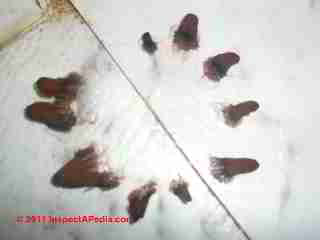 Action: remove the mold and fix the cause for its growth in the first place.
Action: remove the mold and fix the cause for its growth in the first place.
Many Brown Hairy Molds are Probably Harmless
Stemonitis sp. is a Myxomycete ( a class of fungus) that is not listed in our MOLD ATLAS & PARTICLES INDEX
nor in the authoritative Atlas of Clinical Fungi, deHoog et als. as a known toxic mold, though it is commonly described in mushroom field guides such as the National Audobon Society's Field Guide to Mushrooms [1]
But as we warned you earlier, having so much fungal growth and leakage as we saw in that lifted-carpeting photo, you should expect that other genera/species are likely to be present even if you don't see them yourself from a superficial inspection.
Watch out for Other Leaks & Hidden Mold
Watch out: At a minimum you'd be smart to assume there are allergenic molds present and if there is more than about one square meter of moldy material, to use appropriate protection measures during cleanup as well as, of course, finding and correcting the leaks that led to these conditions.
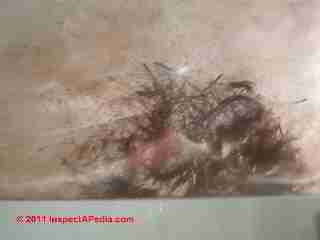 It is not usually necessary to test mold to identify the genera species. That will not change how mold should be removed or prevented in buildings.
It is not usually necessary to test mold to identify the genera species. That will not change how mold should be removed or prevented in buildings.
On occasion, for medical reasons or for control of a costly mold remediation project, there are reasono identify mold in buildings.
Those details are
at s MOLD TEST REASONS.
As we explain at BATHROOM MOLD, mold may be found growing on wood subfloors under bath floor tiles or sheet vinyl flooring if the bathroom floor has been wet or flooded.
If a ceramic bath tile floor has become loose or if bathroom floor carpeting has been wet (as one would expect), we suggest exploring for damaged subfloors - otherwise simply repairing the tiles or replacing moldy carpeting may not be a durable fix.
If the bathroom is not on a basement or slab, inspect the ceiling areas below the bathroom for leak stains.
Stained areas of drywall ceiling below a leaky bathroom or bath fixture usually merit further investigation.
You will want to study the building carefully to decide on the building points at most risk of having been wet from leaks due to construction details or other site observations. That's where one would make a test cut, remove carpeting, or otherwise explore further for hidden mold.
You might want to review MOLD in BUILDINGS and
also HIDDEN MOLD, HOW TO FIND.
See ACTION GUIDE - WHAT TO DO ABOUT INDOOR MOLD on what to do about mold
Research on the Toxicity of Harmfulness of Stemonitis sp. molds - Pathogenicity
Stemonitis sp. is a ubiquitous slime mold fungus that can produce tall hairy brown sporangia (stalks covered with fungal spores) in clusters. In nature we have found Stemonitis on rotting wood; in buildings we have often found Stemonitis, usually S. fusca, growing on wet OSB (Oriented strand board) used as subflooring and occasionally on walls - in all cases where the floor or subfloor has been wet.
One reader (shown in this article) provided photos of what is most-likely S. fusca growing out of the bottom of a hollow-core wooden door (apparently in a wet location).
Whetzel (1901) gave an early table for the speciaStemonition of Stemonitis that we include in the references below.
A search of mycobank (mycobank.org) performed on 2019/08/16 for Stemonitis fusca located the mycobank # 240909 (citing Roth 1787, Magazin für die Botanik 1(2): 26) finding that there was no human pathogenicity code for Stemonitis fusca and no plant pathogenicity code for this fungus.
Li (2004) reports that Stemonitis sp. might be associated with allergy.
This fungus is classified as follows:
Protozoa, Myxomycota, ?, Stemonitales, Stemonitidaceae, Stemonitis
And there were records at speciesfungorum.org citing these Stemonitis species:
Stemonitis aequalis (Peck) Massee (1892), (= Stemonitopsis aequalis); Protozoa Stemonitis aequalis var. aequalis (Peck) Massee (1892), (= Stemonitopsis aequalis); Protozoa Stemonitis alba (Bull.) J.F. Gmel. (1792), (= Physarum album); Protozoa Stemonitis arcyrioides Sommerf. (1827), (= Lamproderma arcyrioides); Protozoa Stemonitis argillacea Pers. ex J.F. Gmel. (1792), (= Cribraria argillacea); Protozoa Stemonitis atrofusca ß nigra Pers. (1797), (= Comatricha nigra); Protozoa Stemonitis aurantia (Bull.) J.F. Gmel. (1792), (= Physarum viride var. aurantium); Protozoa Stemonitis axifera (Bull.) T. Macbr. (1889); Protozoa Stemonitis axifera f. axifera (Bull.) T. Macbr. (1889), (= Stemonitis axifera); Protozoa Stemonitis axifera var. axifera (Bull.) T. Macbr. (1889), (= Stemonitis axifera); Protozoa Stemonitis axifera var. smithii (T. Macbr.) Hagelst. (1944), (= Stemonitis smithii); Protozoa Stemonitis bicolor sensu Fries, (= Stemonitopsis typhina); Protozoa Stemonitis botrytis Pers. ex J.F. Gmel. (1792), (= Trichia botrytis var. botrytis); Protozoa Stemonitis cancellata (Batsch) J.F. Gmel. (1792), (= Cribraria cancellata var. cancellata); Protozoa Stemonitis carestiae Ces. & De Not. (1879), (= Meriderma carestiae); Protozoa Stemonitis cinerea (Bull.) J.F. Gmel. (1792), (= Arcyria cinerea); Protozoa Stemonitis confluens Cooke & Ellis (1876), (= Symphytocarpus confluens); Protozoa Stemonitis confluens var. syncarpa Yamash. (1936), (= Symphytocarpus syncarpus); Protozoa Stemonitis cribrarioides Fr. (1829), (= Meriderma cribrarioides); Protozoa Stemonitis denudata (L.) Relhan (1820), (= Arcyria denudata); Protozoa Stemonitis echinulata Berk. (1859), (= Lamproderma echinulatum); Protozoa Stemonitis elegans Trentep. (1797), (= Diachea leucopoda); Protozoa Stemonitis farrensis T.N. Lakh. & Mukerji (1977); Protozoa Stemonitis favoginea (Batsch) J.F. Gmel. (1792), (= Trichia favoginea); Protozoa Stemonitis ferruginea Ehrenb. (1818); Protozoa Stemonitis ferruginea var. smithii (T. Macbr.) G. Lister (1911), (= Stemonitis smithii); Protozoa Stemonitis ferruginosa Batsch (1786), (= Tubifera ferruginosa); Protozoa Stemonitis flavogenita E. Jahn (1904); Protozoa Stemonitis floriformis (Bull.) J.F. Gmel. (1792), (= Diderma floriforme); Protozoa Stemonitis foliicola Ing (1967); Protozoa Stemonitis fulva (L.) J.F. Gmel. (1792), (= Chaenotheca furfuracea); Coniocybaceae Stemonitis furfuracea (L.) J.F. Gmel. (1792), (= Chaenotheca furfuracea); Coniocybaceae Stemonitis fusca var. flaccida (Lister) Torrend (1908), (= Symphytocarpus flaccidus); Protozoa Stemonitis fusca var. fusca Roth (1787); Protozoa Stemonitis fusca var. nigrescens (Rex) Torrend (1908), (= Stemonitis nigrescens); Protozoa Stemonitis fusca var. rufescens Lister (1894); Protozoa Stemonitis globulifera (Bull.) J.F. Gmel. (1792), (= Physarum globuliferum); Protozoa Stemonitis graciliformis Nann.-Bremek., Mukerji & Pasricha (1984); Protozoa Stemonitis herbatica Peck (1874); Protozoa Stemonitis herbatica var. confluens G. Lister (1911), (= Symphytocarpus herbaticus); Protozoa Stemonitis hyperopta Meyl. (1919), (= Stemonitopsis hyperopta); Protozoa Stemonitis hyperopta var. microspora (Lister) G. Lister (1925), (= Stemonitopsis microspora); Protozoa Stemonitis incarnata Pers. ex J.F. Gmel. (1792), (= Arcyria incarnata); Protozoa Stemonitis inconspicua Nann.-Bremek. (1966); Protozoa Stemonitis laxa (Rostaf.) Massee (1892), (= Comatricha laxa); Protozoa Stemonitis laxifila Nann.-Bremek. & Y. Yamam. (1988); Protozoa Stemonitis leucocephala Pers. ex J.F. Gmel. (1792), (= Craterium leucocephalum var. leucocephalum); Protozoa Stemonitis leucopoda (Bull.) DC. (1805), (= Diachea leucopoda); Protozoa Stemonitis lignicola Nann.-Bremek. (1973); Protozoa Stemonitis longa (Peck) Massee (1892), (= Symphytocarpus longus); Protozoa Stemonitis marjana Y. Yamam. (2000); Protozoa Stemonitis microspora Lister (1894), (= Stemonitopsis microspora); Protozoa Stemonitis mussooriensis G.W. Martin, K.S. Thind & Sohi (1957); Protozoa Stemonitis nigra Pers. ex J.F. Gmel. (1792), (= Comatricha nigra); Protozoa Stemonitis nigrescens Rex (1891); Protozoa Stemonitis nivea J.F. Gmel. (1792), (= Sclerophora pallida); Coniocybaceae Stemonitis nutans (Bull.) J.F. Gmel. (1792), (= Arcyria nutans); Protozoa Stemonitis obtusata Fr. (1829), (= Comatricha nigra); Protozoa Stemonitis ovata var. atrofusca (Pers.) Alb. & Schwein. (1805), (= Comatricha nigra); Protozoa Stemonitis ovata var. nigra (Pers. ex J.F. Gmel.) Pers. (1801), (= Comatricha nigra); Protozoa Stemonitis pallida Wingate (1899); Protozoa Stemonitis papillata Pers. (1794), (= Enerthenema papillatum); Protozoa Stemonitis physaroides Alb. & Schwein. (1805), (= Lamproderma columbinum); Protozoa Stemonitis plana B. Zhang & Yu Li (2017); Protozoa Stemonitis pomiformis (Leers) Roth (1788), (= Arcyria pomiformis); Protozoa Stemonitis pulchella C. Bab. (1839), (= Comatricha pulchella var. pulchella); Protozoa Stemonitis reticulata (H.C. Gilbert) Hertel (1956), (= Stemonitopsis reticulata); Protozoa Stemonitis rhizoideipes Nann.-Bremek., R. Sharma & K.S. Thind (1984); Protozoa Stemonitis rufa Roth (1788), (= Cribraria rufa); Protozoa Stemonitis scintillans Berk. & Broome (1876), (= Lamproderma scintillans); Protozoa Stemonitis sichuanensis B. Zhang & Yu Li (2016); Protozoa Stemonitis smithii T. Macbr. (1893); Protozoa Stemonitis splendens var. confluens Lister (1894), (= Symphytocarpus confluens); Protozoa Stemonitis splendens var. flaccida Lister (1894), (= Symphytocarpus flaccidus); Protozoa Stemonitis splendens var. splendens Rostaf. (1875); Protozoa Stemonitis splendens var. webberi (Rex) Lister (1894); Protozoa Stemonitis subcaespitosa (Peck) Massee (1892), (= Stemonitopsis subcaespitosa); Protozoa Stemonitis syncarpa (Yamash.) Emoto (1977), (= Symphytocarpus syncarpus); Protozoa Stemonitis tenerrima M.A. Curtis (1848), (= Comatricha tenerrima); Protozoa Stemonitis tubulina Alb. & Schwein. (1805), (= Amaurochaete tubulina); Protozoa Stemonitis typhina F.H. Wigg. (1780), (= Stemonitopsis typhina); Protozoa Stemonitis typhina Schumach. (1803), (= Stemonitopsis typhina); Protozoa Stemonitis typhoides (Bull.) DC. (1805), (= Stemonitopsis typhina); Protozoa Stemonitis varia Pers. ex J.F. Gmel. (1792), (= Trichia varia); Protozoa Stemonitis vesparium (Batsch) J.F. Gmel. (1792), (= Metatrichia vesparium); Protozoa Stemonitis violacea Schumach. (1803), (= Stemonitis smithii); Protozoa Stemonitis violacea Fr. (1829), (= Lamproderma arcyrioides); Protozoa Stemonitis virginiensis Rex (1891); Protozoa Stemonitis viridis (Bull.) J.F. Gmel. (1792), (= Physarum viride var. viride); Protozoa Stemonitis webberi Rex (1891), (= Stemonitis splendens var. webberi); Protozoa
- Beguin, Hugues, and Nicole Nolard. "Mould biodiversity in homes I. Air and surface analysis of 130 dwellings." Aerobiologia 10, no. 2-3 (1994): 157.
- Bisby, Guy Richard. "Some observations on the formation of the capillitium and the development of Physarella mirabilis Peck and Stemonitis fusca Roth." American journal of botany (1914): 274-288.
- Clark, Jim. "Myxomycete reproductive systems: Stemonitis species." Mycologia 89, no. 2 (1997): 241-243.
- Collins, O'Neil R., and Hsi-Chang Tang. "Further studies on conversion from non-heterothallism to heterothallism in Stemonitis flavogenita (Myxomycetes, Stemonitales)." Mycologia 80, no. 3 (1988): 405-407.
- Fischer, Guido, and Wolfgang Dott. "Relevance of airborne fungi and their secondary metabolites for environmental, occupational and indoor hygiene." Archives of Microbiology 179, no. 2 (2003): 75-82.
- Hawksworth, David L., and P. E. J. Wiltshire. "Forensic mycology: current perspectives." [PDF] Res Rep Forensic Med Sci (2015).
Abstract:
Abstract: Mycology can contribute to a variety of forensic investigations, including the determination of postmortem intervals from mold growth on corpses, psychoactive substances and toxins, hazards from mold growth in buildings, and providing trace evidence linking people and objects with places.
Studies are also starting to be undertaken to explore the use of molecular data on fungi in the characterization of soils. In addition, where there are health concerns, possibly associated with mold growth in buildings, guidance is presented with respect to the collection of samples, and some caveats are given which must be considered in interpretation of data. Attention is drawn to pertinent publications which either appeared, or came to the attention of the authors, since the review they prepared in 2010.
This is supplemented by examples from their own recent casework. In order to avoid valuable information being overlooked, there is a need for investigating officers, and those involved in forensic medicine, especially pathologists and toxicologists, to be aware of the evidential value of fungi.
In particular, they should not overlook opportunities to recover spores from human remains, to examine any mold colonies growing on corpses, and to analyze gut contents for fungal material and spores. Keywords: fungi, mold, pollen, postmortem interval, spores, toxicology.
This article includes Doratomyces stemonitis among examples of mold fungi associated with indoor damp problems. That is NOT a claim that the Stemonitis itself is pathogenic.
- Hellenbrand, K. E., and A. E. Reade. "Microorganisms associated with fuel wood chips and their impact on indoor air quality: a review." International Biodeterioration & Biodegradation 29, no. 1 (1992): 19-43.
- Hu, Fu-Sen, and Jim Clark. "Axenic culture of the myxomycete Stemonitis flavogenita." Mycologia 78, no. 3 (1986): 478-482.
- Lacey, J., and B. Crook. "Fungal and actinomycete spores as pollutants of the workplace and occupational allergens." The Annals of occupational hygiene 32, no. 4 (1988): 515-533.
Abstract:
Spores of fungi and actinomycetes are almost always present in air but their numbers and types differ with time of day, weather, season and location (especially if this is dominated by large nearby spore sources). Without a source of spores in a building, numbers indoors are usually smaller than outdoors but the types found are similar.
Heaviest exposure to airborne spores is often found in the workplace. Important sources are agricultural crops, especially during harvesting or during handling and processing after storage. mushrooms, wood for timber or pulping, composts, food processing and, increasingly, biotechnological processes. Many of the spores concerned are 1–5 μm in diameter and they may number up to 10 10 spores m −3 air.
Many of the organisms found are well-known allergens and have been implicated in occupational asthma or extrinsic allergic alveolitis. Some may also cause infection, e.g. Aspergillus fumigatus , or carry mycotoxins, e.g. Aspergillus flavus , while very intense exposure may cause ‘organic dust toxic syndrome’. Important factors in the development of occupational asthma and allergic alveolitis are predisposition and the nature, intensity and duration of exposure.
Examples of exposure to fungal and actinomycete spores in different occupational environments are described. - Li, De-Wei, and Chin S. Yang. "Fungal contamination as a major contributor to sick building syndrome." [PDF] Advances in Applied Microbiology 55 (2004): 31-112. Retrieved 2019/08/16, original source: https://www.researchgate.net/profile/De-Wei_Li/publication/8362615_Fungal_Contamination_as_a_Major_Contributor_to_Sick_Building_Syndrome/links/5c06826e299bf169ae316a24/Fungal-Contamination-as-a-Major-Contributor-to-Sick-Building-Syndrome.pdf
As with other articles cited here, this article includes Stemonitis among examples of mold fungi associated with indoor damp problems. That is NOT a claim that the Stemonitis itself is pathogenic. The article suggests by inclusion in a very long list, that Stemonitis may be a fungal genera associated with allergies. - Loganathan, P. (1998) Production of DL-DOPA from acellular slime-mould Stemonitis herbatica. Bioprocess Engineering, 18, 307-308.
- Indira, Pattada U. "The life-cycle of Stemonitis herbatica." Transactions of the British Mycological Society 53, no. 1 (1969): 25-IN2.
- Indira, Pattada U. "The life-cycle of Stemonitis herbatica. II." Transactions of the British Mycological Society 56, no. 2 (1971): 251-IN16.
- Peterson, Robyn, Jasmine Grinyer, and Helena Nevalainen. "Secretome of the coprophilous fungus Doratomyces stemonitis C8, isolated from koala feces." Appl. Environ. Microbiol. 77, no. 11 (2011): 3793-3801.
- Whetzel, H. "Notes on the genus Stemonitis." In Proceedings of the Indiana Academy of Science, vol. 11, pp. 261-266. 1901.
...
Reader Comments, Questions & Answers About The Article Above
Below you will find questions and answers previously posted on this page at its page bottom reader comment box.
Reader Q&A - also see RECOMMENDED ARTICLES & FAQs
On 2021-05-01 by (mod) - red hairy mold growing at floor means hidden mold & damage: clean up and fix leaks
@bellamama.vf,
Thanks for a nice mold photo.
I have to say that red hairy mold is not a species I can identify by eye alone; it may be a species of Stemonitis or a similar slime mold;
Fortunately we don't need to identify that mold to know what to do. In fact knowing the genera/species of mold won't change what's needed at all. What's important is to recognize that when we have a slime mold or other fungus like that in your photo growing up out of a floor, we know that conditions have been wet and we can expect hidden rot.
Find the mold reservoirs in the building: that means, in a case like this one where mold is grousing up out of a floor, inspecting below, particularly if this is a photo from indoors.
Remove the mold by cleaning
Fix the cause (leaks, or if outdoors, poor sealing and drainage at a porch or deck)
On 2021-04-30 by bellamama.vf
What is this mold anyone know. Please help.
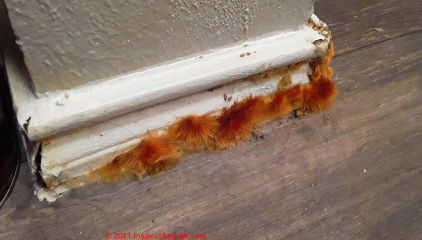
On 2020-05-15 by danjoefriedman (mod) - Stemonitis means wet which means other molds present too
Aimee
Note that finding Stemonitis simply tells us that the building has been wet and mold is growing; there will virtually never be just one mold genera/species present. Fortunately what's needed doesn't depend on mold identification.
That black moldy drywall wasd, of course, a different genera/species of mold.
Removing and tossing out moldy drywall was the right step.
Fixing the leak cause is essential.
For an area of contiguous moldy materials less than 30 sqft. , hiring a mold remediation company is mot necessary nor recommended.
On 2020-05-15 by Aimee
Thanks Dan. Tests came back that it is indeed STEMONISTIS. My home is still under warranty so the drywall experts came out and removed some drywall around my window seal and found mold rotting in the wood supporting the top frame of my window.
I believe my warranty advisor removed/threw away the drywall pieces it had spread to and remediation services sprayed killz on it so no way to get that tested. Unfortunately they didn’t follow protocol in some areas and although I gave requested a remediation company and mold specialist of my choice, I wasn’t allowed one.
For anyone reading this And looking for insight, I have since found out that it’s my legal right to request one.
I will be requesting one as they move forward with repairs and ask for a Mold Clearance Certificate to ensure my home will be free if mold. Dan, any thoughts as you look at the photo of my drywall?
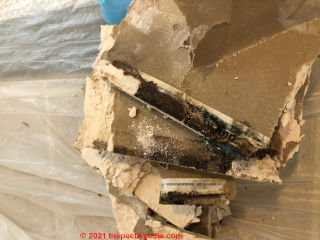
On 2020-05-08 - by (mod) -
Hi Aimee, thanks for the photo and the question.
Your photo shows Stemonitis, growing on the surfacae of what looks like a bracket, perhaps for an air conditioner.
If there was an AC unit or something else that leaked water into that area that might well explain the mold growth.
Regarding the phrasing of your question "Is this a fungus or mold?" - mold and fungus are synonyms in this case. What we are seeing in the photo is the fruiting body of Stemonitis, a mold, or fungus.
Keep in mind that what you see is a "water indicator" mold - other mold genera/species will be present, often hidden in wall, ceiling, or floor cavities.
What's needed is to find the mold reservoir and remove it and fix the leaks.
Fungus and "mold" and "mushrooms" are all describing the same family of organisms.
On 2020-05-08 by Aimee - Stemonitis growing at windows in two year old home
My home is only two years old but we’ve had problems with this window. Is this a fungus
Or mold?

On 2020-04-23 - by (mod) -
Anon
What you can see - probably a fungus - is trivial in amount. Any household cleaner + paper towels to wipe up the mess will be sufficient.
Alchohol isn't necessatry and in general, "killing" mold is not a useful objective. See those details at MOLD KILLING GUIDE https://inspectapedia.com/mold/How_to_Kill_Black_Mold.php
Watch out: however; whatever this is, mold or a bit of insect frass, it may be only the smallest visible portion of a larger problem hidden from view under the cabinet base. An essential step is to find and stop any water leaks into or under the cabinet base.
Regarding your question: how do I clean up this "mold" (if it is mold)?
Please see MOLD CLEANUP GUIDE- HOW TO GET RID OF MOLD
On 2020-04-23 by Anonymous
Thank you for your reply!
Yes, I thought I'll just try and clean it away, but was a bit afraid of spreading the thing, or getting baby insects all over if it's an insect nest of some sort. I've tried throwing alcohol over it last night but it hasn't reacted, so I'm guessing it's mold and not insects. Here's a closer photo, though I understand even this one isn't clear
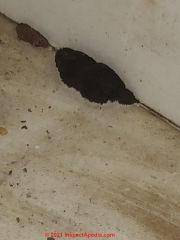
On 2020-04-22 - by (mod) - what is this brown stuff under my sink?
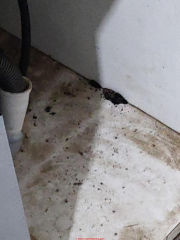 Anon
Anon
On enlargement the photo is a bit blurry - I'm not sure what we're seeing; that looks a bit like insect damage or deteriorated chipboard in a kitchen cabinet base.
Use any household cleaner to spray and wipe and clean, then do a bit of gentle probing to see the condition and extent of damage of the cabinet base and wall.
I also see what looks like an open drain trap under the sink, fed by a flexible drain line - possibly a leak or moisture or sewer gas source, but there's not enough information to know for sure what that is.
On 2020-04-22 by Anonymous
This is under the sink, which has not been cleaned in forever. I'm trying to identify if this is even mold or some sort of insect nest, and how to remove it
On 2020-01-04 - by (mod) -
Mike
That could be a fungus although it is not one that I recognize. It's a very small amount. You should just remove it and clean the area using any household cleaner. If you thought there was a water leak into the wall cavity itself that would be a more serious matter and would deserve further investigation.
But given the location I suspect it's just organic debris sprouting mold or fungus in a wet corner of a shower door track
On 2020-01-04 by Mike
We were away for a couple weeks, and came back to this growing in the corner of our shower. Is this brown mold? We're at a loss.
Reader Question: what is this brown stuff on my window sill?
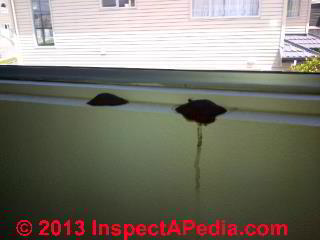 I googled Brown Mould and your website seemed to have the most info. Just out of interest I am wondering if you have come across a brown mould similar to what is shown in the attached picture before.
I googled Brown Mould and your website seemed to have the most info. Just out of interest I am wondering if you have come across a brown mould similar to what is shown in the attached picture before.
These 2 brown blobs were discovered on a window sill at home that were not there 3 days before due to the room being cleaned out for guests (ie must have been very fast growing).
Each measured approx. 2 inches long x ½ inch high x ½ inch wide.
My house is constructed from concrete filled reinforced blocks that has 8 inch thick walls. Whilst cleaning them up I noticed they had a vertical spore formation and had very fine chocolate brown coloured dust. Any information would be much appreciated.
Regards, R.C. 11/21/2013
Reply:
A competent onsite inspection by an expert usually finds additional clues that would permit a more accurate, complete, and authoritative answer than we can give by email alone.
You will find additional depth and detail in articles at our website. In particular, take a look at some of my Stemonitis photos at BROWN HAIRY BATHROOM MOLD.
That fungus, often found in buildings, has different appearances depending on its age, growth substrate, and environmental conditions. It can become a brown blobby mess. The stuff in your photo - well there is just no detail for me to examine.
All I can make out in your photo is a pair of brown blobs. But if at different points in the material's life cycle it looked like my Stemonitis then that may be what it is. I have found this fungus growing on bath tiles at grout joints, and on OSB subflooring in bathrooms and occasionally in other building areas.
The Stemonitis sp. itself is not a particular health worry. But I'd be looking for a hidden leak at the window sill and possibly other hidden water damage.
On 2019-08-16 by (mod) - Is Stemonitis pathogenic? No.
 Stemonitis is not itself a harmful mold (to people): In searching various clinical references to mold toxicity, I found no citation of any of the Stemonitis species as toxic or pathogenic. (See the Atlas of Clinical Fungi for example.)
Stemonitis is not itself a harmful mold (to people): In searching various clinical references to mold toxicity, I found no citation of any of the Stemonitis species as toxic or pathogenic. (See the Atlas of Clinical Fungi for example.)
Watch out: However it is VIRTUALLY NEVER the case that when you find a particular mold growing in a building that only one single mold genera/species present; you're reporting what's visually obvious, that's all.
Watch out: That means that while Stemonitis sp. (for example Stemonitis fusca) itself may be harmless or at most an allergen to some people, it's also an indicator of wet building conditions that can have produced other more-harmful mold genera/species that you simply did not see.
For example the same conditions that produced Stemonitis on a building material (normally wood) may produce species of Aspergillus or Penicillium, far more likely to be harmful, potentially toxic or pathogenic fungii.
Really? In any event if you've got less than 30 sq.ft. of contiguous mold it's a handyman cleanup job not a case for calling in the mold-is-gold hazmat team in white tyvek suits.
On 2019-08-16 by Mouri
Hello , thank you for your reply, I believe my blood pressure just came back to normal, I was that worried. Yes, the door is made up of wood and the caretaker is going to replace it and burn it, and bleach the whole floor.
So, is it pathogenic? Do I have to watch out for rashes to break out, etc? The stems and umbrella like heads were pure white before, and looked quite like agaricus before they shrunk and turned black.
Anyway thanks for answering, and here's another shot of the same.
On 2019-08-15 by (mod) - brown hairy mold in hostel batyhroom
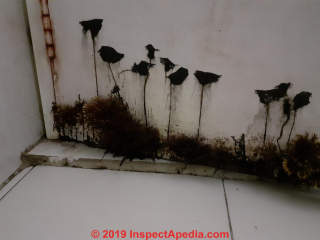 Yep this website is "alive"
Yep this website is "alive"
And that's an impressive mold growth.
This is probably the same fungus as discussed on the page above. No need to panic. Remove the mold, fix the leaks, clean and then paint metal surfaces - if that's a metal door. If it's a wood door I suspect there's rot and replacement would be in order.
On 2019-08-15 by Mouri
I hope this site is still alive, because we have big ( at least a foot long) nasty musty disgusting scary hairy fungus problem in our hostel bathroom.
The furs are more than 6 inches long, the stems and mushroom like heads are black now but they were white last night. They came out of nowhere and flourished and covered up the bottom of the wooden door within one night.
Especially on the moist side of the door to this community shower stall. Color is dark brown to black , but sometime light brown to yellowish at the tips.
It rained last night, and the day before. And the exhaust fan stopped working as well. So it likes humidity.
The caretaker will change the door, and probably burn it, but what precautions should we take? Is it pathogenic? Can you tell from the photo?
On 2018-08-06 by (mod) -
Nice photos, yes this looks like the same genera/species discussed on this page - at least it's a Stemonitis. Any household cleaner will be fine. Drying out the deck above and below help so if the deck is not draining well or has no air circulation below those could be factors in mold growth.
On 2018-08-05 by David
I have 2 spots of brown hairy mold that popped up from nowhere on my outdoor deck which has tree limbs over the area. When touched with a pine needle turned to brown dust. Now within 24 hours 2 more popped up within 2 feet of where the others were
IMAGE LOST by older version of Comments code - now fixed. Please re-post the image if you can. Sorry. Mod.
On 2018-08-04 by (mod) -
Looks like Stemonitis - I suspect you have a leak under the flooring that is wetting the subfloor made of OSB or plywood.
On 2018-08-04 by Asherdee
Here’s another picture of the brown hairy mold
IMAGE LOST by older version of Comments code - now fixed. Please re-post the image if you can. Sorry. Mod.
I’m trying to figure out what this is. I’ve cleaned and it come back a week later. Brown hairy looking but turn to dust when cleaned.
IMAGE LOST by older version of Comments code - now fixed. Please re-post the image if you can. Sorry. Mod.
On 2018-05-22 by Linda
Thank you for your reply.
On 2018-05-21 by (mod) -
Linda
You posted at BROWN MOLD PHOTOS https://inspectapedia.com/mold/Brown_Mold_Pictures.php
but your new photo below is clearly a species of Stemonitis sp.
Pouring bleach is never an effective way to get rid of a mold problem - nor to make mold "safe"
The bleach will: expose you to bleach hazards, damage the floor, maybe "kill" some of the mold but even dead mold spores can remain toxic or allergenic
See MOLD CLEANUP, BLEACH
You will want to investigate further, remove moldy materials that can't be cleaned, clean hard surfaces, and fix the leaks that are causing the mold growth.
On 2018-05-21 by Linda
I’m not sure if this is the site I asked already... but I’m sending a clearer picture wondering what kind of mold... when I poured bleach on it... it “poofed” brown dust clouds.
IMAGE LOST by older version of Comments code - now fixed. Please re-post the image if you can. Sorry. Mod.
On 2018-04-09 by (mod) -
Nancy,
From just your comment I cannot identify what the fuzzy black stuff is in your home. It would be unlikely that fuzzy mold would be all over tile floors, but of course there could be other dust or particle sources that could be allergenic or otherwise harmful.
After discussing your concern with your doctor, you might want to start
at MOLD / ENVIRONMENTAL EXPERT, HIRE ? - when to hire an expert
and if you need someone on site
see CONSULTANTS & EXPERTS DIRECTORIES
Beware of "expert mold test people" who simply stop by to grab a test sample or two to send to a mold lab. Such testing is not diagnostic - even if "mold" is confirmed as "a problerm" you have not been told what cleanup and repairs are needed.
On 2018-04-09 by Nancy Sylvain
I have fuzzy black stuff in my bathroom and kitchen tile on the floors, I am breaking out all the time and itchy its like dust and flys around I keep sweeping but it is always back a few hours later What is it?
...
Continue reading at MOLD BEHIND MARBLE or TILE or select a topic from the closely-related articles below, or see the complete ARTICLE INDEX.
Or see these
Recommended Articles
- BATHROOM MOLD REMOVAL / PREVENTION
- BROWN MOLD PHOTOS - brown mold found in buildings and "should I buy a home that has a mold problem?"
- MOLD APPEARANCE - WHAT MOLD LOOKS LIKE
- MOLD GROWTH on SURFACES, PHOTOS
Suggested citation for this web page
BROWN HAIRY BATHROOM MOLD at InspectApedia.com - online encyclopedia of building & environmental inspection, testing, diagnosis, repair, & problem prevention advice.
Or see this
INDEX to RELATED ARTICLES: ARTICLE INDEX to MOLD CONTAMINATION & REMEDIATION
Or use the SEARCH BOX found below to Ask a Question or Search InspectApedia
Ask a Question or Search InspectApedia
Questions & answers or comments about the identification, cause, & cure of brown hairy mold and other brown bathroom molds. .
Try the search box just below, or if you prefer, post a question or comment in the Comments box below and we will respond promptly.
Search the InspectApedia website
Note: appearance of your Comment below may be delayed: if your comment contains an image, photograph, web link, or text that looks to the software as if it might be a web link, your posting will appear after it has been approved by a moderator. Apologies for the delay.
Only one image can be added per comment but you can post as many comments, and therefore images, as you like.
You will not receive a notification when a response to your question has been posted.
Please bookmark this page to make it easy for you to check back for our response.
IF above you see "Comment Form is loading comments..." then COMMENT BOX - countable.ca / bawkbox.com IS NOT WORKING.
In any case you are welcome to send an email directly to us at InspectApedia.com at editor@inspectApedia.com
We'll reply to you directly. Please help us help you by noting, in your email, the URL of the InspectApedia page where you wanted to comment.
Citations & References
In addition to any citations in the article above, a full list is available on request.
- In addition to citations & references found in this article, see the research citations given at the end of the related articles found at our suggested
CONTINUE READING or RECOMMENDED ARTICLES.
- Carson, Dunlop & Associates Ltd., 120 Carlton Street Suite 407, Toronto ON M5A 4K2. Tel: (416) 964-9415 1-800-268-7070 Email: info@carsondunlop.com. Alan Carson is a past president of ASHI, the American Society of Home Inspectors.
Thanks to Alan Carson and Bob Dunlop, for permission for InspectAPedia to use text excerpts from The HOME REFERENCE BOOK - the Encyclopedia of Homes and to use illustrations from The ILLUSTRATED HOME .
Carson Dunlop Associates provides extensive home inspection education and report writing material. In gratitude we provide links to tsome Carson Dunlop Associates products and services.


